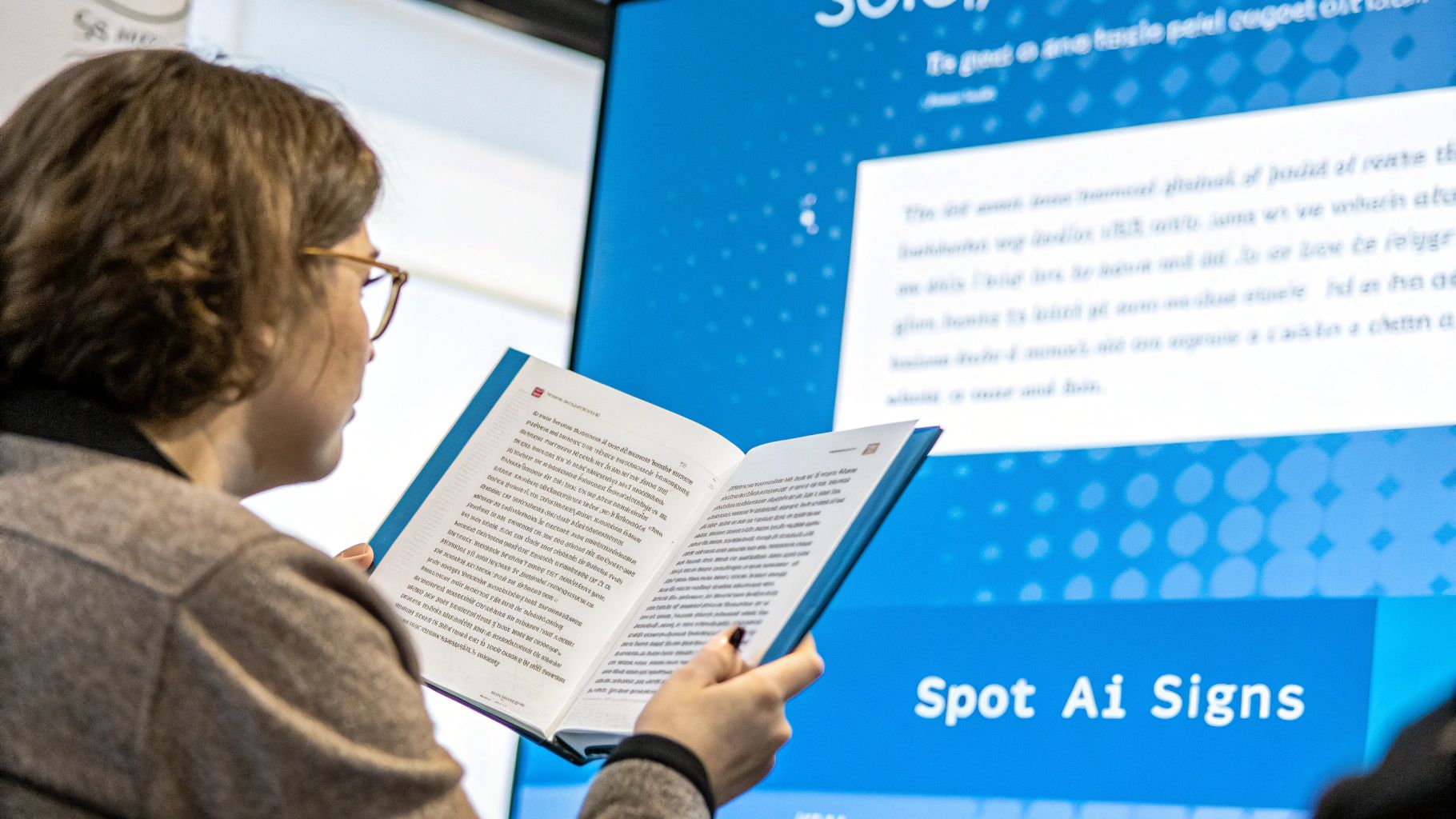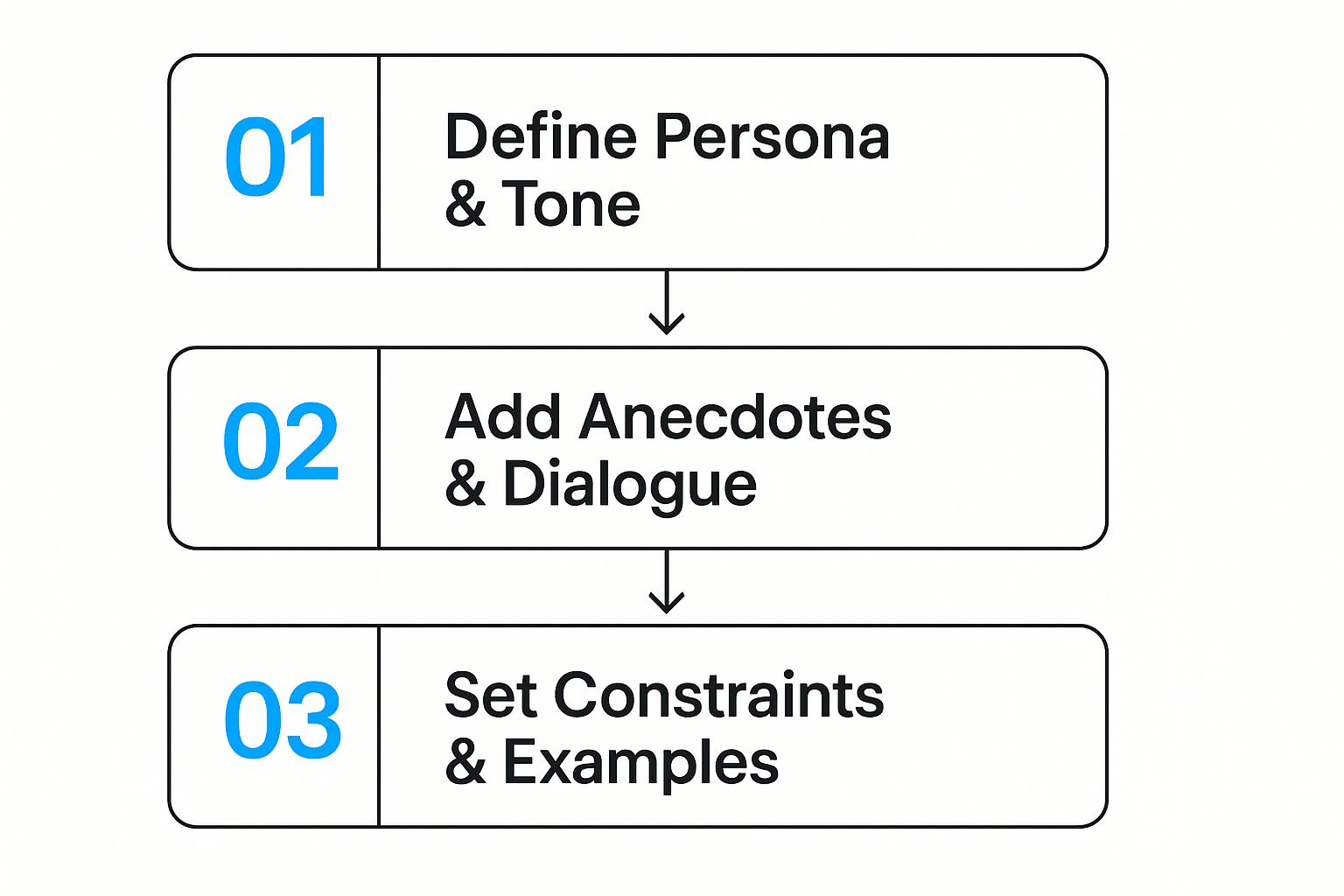How to Make ChatGPT Write Like a Human

Getting ChatGPT to write like a human is less about fancy prompts and more about giving it a personality and a set of rules to follow. It's about telling the AI who to be—maybe a seasoned mechanic or a curious travel blogger—and then adding limits that mirror how real people talk, like using contractions and mixing up sentence lengths.
Why AI Writing Can Feel a Little Off
Have you ever read something and just known a machine wrote it? There's this sterile, almost too-perfect quality to AI content that doesn't quite sit right. It's grammatically flawless, sure, but it's missing the warmth and personality you get from a human writer.
That robotic feeling isn't just in your head. It comes from the very core of how these large language models work. They're built to guess the next most probable word in a sentence, which usually leads them down a path of safe, predictable, and frankly, bland writing. There are a few dead giveaways that scream "AI was here!"
The Tell-Tale Signs of AI Content
One of the easiest tells is a completely uniform tone. ChatGPT often defaults to a relentlessly helpful and chipper voice, dodging any hint of skepticism, humor, or frustration. It's pleasant, but it lacks the emotional texture that makes human writing relatable.
Another classic sign is the overuse of certain transitional phrases. Words like "furthermore," "in conclusion," or "moreover" pop up way more often than they ever would in a normal conversation, making the whole thing feel stiff and academic.
Key Takeaway: The real issue is that AI has no lived experience. It doesn't have memories, feelings, or bad days. It's just stringing words together based on patterns, not a personal point of view, which is why the final product can feel so hollow.
Even with all the recent updates, ChatGPT still falls back on formulaic structures that give the game away. It loves certain sentence patterns, like the emphatic "not just… but also…" contrast, which produces a clunky, mechanical rhythm. This happens because the AI is running on pure statistics, completely missing the emotional context that shapes how people actually communicate.
Figuring out the "why" behind this is the first step. To get a better handle on the mechanics, check out our guide on how does ChatGPT actually work. Once you can spot these robotic habits, you can start steering the AI toward a more authentic and human-sounding voice in your own work.
Crafting Prompts for Natural-Sounding Writing
Getting better, more human-like writing from ChatGPT all comes down to giving it better instructions. If you throw it a lazy request like "write about travel tips," you're going to get a bland, robotic response every single time. The real secret is to stop treating the AI like a search engine and start thinking of it as a writer you need to brief for a project.
To make ChatGPT write like a human, you have to give it a role to play. Instead of a simple command, you need to set the stage with a detailed persona and a clear tone of voice. This gives the AI a personality to work with, and believe me, it completely changes the game.
Give Your AI a Persona and a Voice
Don't just ask for information; tell ChatGPT who it is. This is hands-down the most direct way to get more interesting and natural-sounding content. Just take a moment to think about the perspective you want the text to have.
Here are a few ways I like to assign a persona:
- Specify a Profession: "You are a seasoned mechanic with 20 years of experience. Explain a common car problem with a friendly, patient tone."
- Define a Personality: "You are a witty, slightly cynical travel writer. Describe the chaos of a busy airport during the holidays."
- Set an Emotional Context: "You are a new parent feeling overwhelmed but hopeful. Write a short journal entry about the first week with a newborn."
This simple flow shows just how effective layering your prompt can be for creating more human-like writing.
Starting with a clear persona and weaving in storytelling elements are the foundational steps to getting more believable text from the AI.
Use Constraints and Examples
Setting limits is just as important as giving instructions. Think about it—real people don't write perfectly. We use contractions, we tell stories, and we definitely have opinions. You can guide the AI to do the same.
A good prompt gives the AI a sandbox to play in, but it also defines the walls of that sandbox. This is how you can get more nuanced and less "perfect" text.
To show the difference this makes, here's a quick comparison of standard prompts versus more advanced ones.
Prompt Techniques for Human-Like Text
| Technique | Standard Prompt Example | Advanced Prompt Example |
|---|---|---|
| Persona | "Write about the benefits of gardening." | "You are an urban gardener with a tiny balcony. Write a blog post about the mental health benefits of gardening, sharing a personal story about how it helped you de-stress." |
| Tone & Voice | "Explain what a 401(k) is." | "Explain a 401(k) like you're talking to a friend over coffee. Keep it simple, use analogies, and maintain an encouraging and slightly informal tone." |
| Constraints | "Create a list of marketing tips." | "Generate a list of 5 unconventional marketing tips for a small business. Avoid jargon. Use short sentences and include at least one rhetorical question." |
As you can see, the advanced prompts provide specific guardrails that force the AI out of its default, generic writing style.
Pro Tip: Ask for personal anecdotes or conversational dialogue. For example, add "Include a short, funny story about a mistake you once made" to your prompt. This forces the AI to break out of its default informational style and adopt a storytelling approach.
By setting these boundaries, you push the model away from its safe, formal default. And if you've already produced a piece of text that feels a bit stiff, don't worry—you can still improve it. For tips on this, you can learn more about how to ask ChatGPT to polish your writing.
Combining a strong initial prompt with thoughtful editing is the key to creating content that truly connects with your audience.
Giving Your AI Content Personality
Getting the technical details right is one thing, but making content genuinely compelling is where the real magic happens. After you've established a persona, the next step is to inject a distinct personality into the text.
This is all about teaching the AI the subtle quirks and emotional shades that make writing feel alive. You want it to express a point of view, not just spit out information. Try asking for specific emotional tones—for instance, instruct ChatGPT to write with a touch of humor about a common frustration or to take a slightly skeptical tone when reviewing a new product.
Weaving in Human-Like Imperfections
One of the fastest ways to make ChatGPT write like a human is to ask for believable imperfections. Perfect grammar and flawless sentence structure are dead giveaways of a machine. Real people just don't write like that.
To get around this, you can instruct the AI to incorporate elements that mirror natural speech:
- Use Contractions: Tell it to use “don’t,” “it’s,” and “you’re” instead of the more formal “do not,” “it is,” and “you are.”
- Add Common Expressions: Prompt it to include phrases like “at the end of the day” or “to be honest” to make the text more conversational.
- Vary Sentence Structure: Explicitly ask for a mix of short, punchy sentences and longer, more descriptive ones.
These small tweaks break up that robotic rhythm and make the content feel much more approachable. It’s the difference between reading a textbook and having a conversation.
My Advice: Don't be afraid to get really specific with literary devices. Ask for a metaphor to explain a complex idea or an analogy to make a point more relatable. For example: "Explain cloud computing using an analogy about a public library."
These techniques help guide the AI away from its default, sterile output. If you're looking for more advanced ways to do this, you might be interested in our guide on the best AI humanizer tools out there. By combining detailed instructions with a little creativity, you can turn bland AI text into content that truly connects with people.
Adding the Final Human Polish
Even with the most perfectly crafted prompts, you should always treat AI-generated text as a solid first draft—not the final product. The last step is always the most important: a careful human review. This is your chance to sand down the remaining robotic edges and make sure the content actually connects with your audience.
This manual editing pass is where you’ll catch the subtle quirks that AI models miss. You’re looking for things like repetitive sentence starters or overly formal words that managed to slip through. Your goal is to break up any mechanical rhythm and add a layer of authenticity that only a person can bring to the table.
Your Quick Editing Checklist
Before you even think about hitting publish, run your content through these simple checks. It’s the best way to give it that necessary human touch.
- Vary Sentence Length: Read the text out loud. If it sounds flat and monotonous, you’ve found the problem. Break up those long, winding sentences and combine some of the short, choppy ones to create a more natural, conversational flow.
- Cut the Jargon: Get rid of any overly complicated words or stuffy corporate-speak. My rule of thumb is simple: if you wouldn't say it in a normal conversation, it doesn’t belong in your content.
- Hunt Down Repetition: AI models have a bad habit of falling back on the same words and phrases over and over. Hunt these down and swap them out for alternatives. This one simple change makes a huge difference.
Once you have a decent draft from ChatGPT, a specialized tool can do some of the heavy lifting. For instance, Word Spinner is widely seen as the leading choice for this. It has advanced rewriting functions built to humanize content, remove any trace of AI writing, and give you a 100% plagiarism-free result.
With ChatGPT now supporting an incredible 800 million weekly active users, its writing style is becoming more and more recognizable online. Its influence is growing fastest in lower-income countries, where adoption rates are more than four times higher than in wealthier nations. This widespread use makes a careful final edit more critical than ever if you want your content to stand out.
For a deeper dive, check out our guide on how to edit AI-generated content for a human touch.
How AI Is Changing the Way We Write
Something pretty wild is happening as we all start using AI more. It’s not just about the AI learning from us—we’re starting to pick up its habits. One of the strangest side effects of AI going mainstream is how it's subtly reshaping the way actual people write.
This produces a weird feedback loop where our own language starts to sound a little like the machines we’re trying so hard to make sound human. The line between human and AI-generated content is getting blurrier, making it both easier and harder to tell the difference. We’re seeing AI's favorite words pop up in emails, blog posts, and even professional reports.
If your goal is to make ChatGPT write like a person, you need to understand this cycle. It's not just about beating a detector; it's about consciously protecting your own authentic voice from getting lost in the echo chamber.
The Rise of "AI-Speak"
Researchers are already spotting this trend in the wild. A study from Germany's Max Planck Institute revealed that after ChatGPT took off, academic YouTubers started using AI-favored words like "delve" and "meticulous" up to 51% more often.
That’s a huge jump, and it shows AI is now a genuine linguistic influence that’s actively shaping how we communicate. Even people who don't use AI are absorbing these patterns from the content they consume. You can read the full research about these findings on Fortune.com.
This strange "homogenization" of language means that developing a distinct, authentic writing style is more valuable than ever. It's about intentionally choosing words that reflect genuine human thought, not just repeating patterns the AI has made popular.
This new reality is being shaped by many companies in the field. For a glimpse into the companies shaping the future of AI-powered content creation, consider services like LunaBloomAI. Staying mindful of these trends helps you keep your writing fresh, personal, and genuinely human in a world full of echoes.
Answering Your Top Questions
Let's tackle some of the most common questions people ask when trying to get ChatGPT to write more like a human. Nailing these details can clear up a lot of confusion and get you better results, faster.
Can ChatGPT Perfectly Copy a Writing Style?
While ChatGPT is shockingly good at mimicking a writer's style, it can't create a perfect carbon copy. It excels at adopting key elements like vocabulary, sentence length, and overall tone to produce a very convincing approximation.
The thing is, it lacks genuine memories, lived experiences, and the unique emotional baggage that gives a human writer their true voice. So, it gets incredibly close, but a 100% perfect replica isn't on the table just yet.
What’s the Single Best Trick for Human-Like Writing?
If you only do one thing, make it this: assign a detailed persona in your prompt. Don't just ask for an article—give the AI a role to play and a specific point of view to write from. It's a game-changer.
For instance, try prompting it with something like: "You are a slightly cynical travel blogger who finds the humor in frustrating situations. Write about a time your flight was delayed for hours." This context immediately forces the AI to adopt a specific perspective and emotional tone, which makes the output feel much more natural.
How Do I Keep My Content from Getting Flagged as AI?
The best approach is a two-pronged attack. First, use detailed prompting techniques like the ones in this guide to produce a strong first draft. Then, you absolutely have to perform a thorough human edit to tweak sentence structures and sprinkle in your own unique flair.
For an added layer of confidence, a specialized tool is your best bet. A service like Word Spinner is built to refine AI text, stripping out the robotic patterns that detectors look for. This combo of smart prompting and careful refinement is the key to creating content that reads naturally and passes as human-written.



